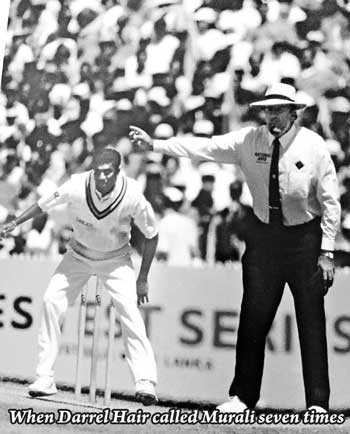Friday Apr 19, 2024
Friday Apr 19, 2024
Saturday, 24 November 2018 00:00 - - {{hitsCtrl.values.hits}}
 It’s been eight years since Muttiah Muralitharan retired after setting up a world record for the most wickets in both Test and One-day cricket. He got his 800th and final wicket on 22 July 2010 from his final ball in his last Test match.
It’s been eight years since Muttiah Muralitharan retired after setting up a world record for the most wickets in both Test and One-day cricket. He got his 800th and final wicket on 22 July 2010 from his final ball in his last Test match.
Unlike many others Murali, as he is affectionately called, continues to be remembered. Though he played for the Tamil Union, a plaque is being unveiled tomorrow at the SSC (Sinhalese Sports Club) to celebrate his record at the Club ground. He claimed 166 Test wickets at SSC, a World Record at a single venue.
Only two other bowlers – James Anderson (103 wickets at Lord’s) and Rangana Herath (102 wickets at Galle) – have taken more than 100 wickets at a single venue.
In addition to his record-breaking performance at the SSC, Murali also has taken 117 wickets at Asgiriya and 111 wickets at Galle.
Murali has won recognition at various places and awards presentations. At the time he was inducted into the ICC Hall of Fame, he was the only Sri Lankan to be honoured in that fashion. He continues to occupy a place in the Bradman Museum’s International Hall of Fame at Bowral in Australia.
When we visited the Museum last year there was a showcase devoted to Murali’s cricket paraphernalia. Among the displayed items were a cap, a tee-shirt, a blazer with Sri Lanka Cricket (SLC) logo, a SLC tie and a bat autographed by the Sri Lanka team under Sanath Jayasuriya. Apart from Murali being recognised, it was certainly a big boost for Sri Lanka cricket.
Murali hit the headlines when umpire Darrel Hair called him seven times in three overs for throwing before a crowd of over 55,000 spectators in the Second Test with Australia in December 1995.
In Geoff Armstrong’s ‘The 100 Greatest Cricketers’, Murali appears in the second of nine teams picked by him. Introducing Murali, he mentions that it is impossible to discuss the quality of Murali without focussing on his bowling action.
“His most vehement detractors reckoned he was a cheat. His supporters called him a genius. He was, most likely, the toughest off-spinner batsmen ever had to confront. Given all that he went through, and fact he was such a prolific wicket-taker for so long, he also has to be one of the toughest cricketers to have ever played the game,” he writes.
Stating that at first glance, the manner in which Murali bowled looked illegal, the author adds that he often appeared to spear his off-break, the ball coming out with a jerk as his arm was propelled towards the batsman. Slow-motion replays added to the confusion: maybe he was okay…
“Biomechanics examined Murali’s action in off-field experiments and concluded that a congenital defect in his arm meant he was incapable of straightening it, but when he bowled there  was an illusion that the arm did straighten, caused at least in part by way he flicked his wrist (which his fans said was more elastic than most). Armstrong sums up Murali’s performance: “Murali’s career continued on to the 2011 World Cup, when Sri Lanka was beaten in the final by India. When he retired from Test cricket he had taken 92 more Test wickets than any other bowler, and 378 more wickets in Tests and ODIs combined. After those no-ball calls in that Melbourne Test, he took 719 wickets at 21.47. For all the fine efforts of the left-arm fast-medium Chaminda Vaas, in the main the great off-spinner carried the Sri Lankan attack for 15 years from 1996.
was an illusion that the arm did straighten, caused at least in part by way he flicked his wrist (which his fans said was more elastic than most). Armstrong sums up Murali’s performance: “Murali’s career continued on to the 2011 World Cup, when Sri Lanka was beaten in the final by India. When he retired from Test cricket he had taken 92 more Test wickets than any other bowler, and 378 more wickets in Tests and ODIs combined. After those no-ball calls in that Melbourne Test, he took 719 wickets at 21.47. For all the fine efforts of the left-arm fast-medium Chaminda Vaas, in the main the great off-spinner carried the Sri Lankan attack for 15 years from 1996.
“It is no real surprise that he took five wickets in a Test innings and 10 wickets in a Test more often than any other bowler. His best performance, statistically at least, came against England at The Oval in 1998, when he bowled 13.5 overs to take 16-220 (7-155 & 9-65), the fifth best analysis in all Tests. He is the only man to have bowled more than 7,000 overs in Tests and more than 10,000 overs in Tests and ODIs combined. The stress such an unusual arm action puts on his body makes his longevity a marvel.”